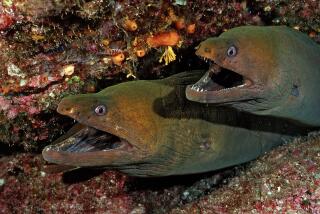Ocean Study Shows Effects of Global Warming
- Share via
Scientists studying 60 years in the life of a Monterey Bay tidal zone will report today that whole populations of sea creatures, including snails, crabs, starfish and anemone are migrating northward in reaction to rising ocean temperatures.
Although the shifts may have been helped along by a number of factors, including the El Nino effect, the population changes may provide intriguing new evidence of the impact of global warming.
“The fact that creatures who prefer warmer water are now thriving in a place where they were once relatively rare came as a big surprise to us,” said Charles Baxter, one of two scientists at the Monterey Bay Aquarium Research Institute who headed the research project. “What we see is evidence that the effects of global warming may already be apparent, at least in the Northern Hemisphere.”
Baxter and three colleagues published their findings in a paper appearing in today’s issue of the journal Science.
There is broad agreement among scientists that the Earth has gotten warmer by at least a degree during the past 100 years. But there is considerable controversy over the impact climate change is having on the Earth. There is also much disagreement on whether human-generated greenhouse gases such as carbon dioxide are fueling the increase in temperature and whether they could lead to disastrous fluctuations in weather patterns.
In the Monterey Bay study, scientists returned to the exact location of a research project done in the early 1930s that took stock of the creatures inhabiting a 35-square-yard patch of rocks and tide pools.
Baxter said he conceived of the study while walking the shore and noticing, over several years, an increase in the numbers of Serpulorbis squamigerus, a type of southern snail that attaches itself permanently to rocks.
Baxter and his colleagues were able to cover the same ground as the earlier study because the brass bolts fastened to the bedrock in 1931 to map the grid of the original project were still in place.
The new study documented dramatic changes in the dispersion of 16 invertebrate species. In an inch-by-inch inventory, the aquarium’s research team documented significant increases in the population of eight species more commonly found in Southern California, and a decrease in five northern species that the 1930s study found in abundance.
The scientists attribute the population shifts to a slow, steady warming trend.
*
“The 60-year period of faunal and floral change coincided with . . . warming of ocean and air temperatures along the western North American coast,” the researchers wrote.
Over 60 years, according to the scientists, the average shoreline temperature has risen a bit over 1 degree, while the average maximum water temperature has gone up 4 degrees.
The El Nino phenomenon of unusually warm currents generated in the central Pacific could be a factor in altering the balance of Monterey Bay species. But the scientists point out that El Nino is a temporary force.
“As a periodic event, El Nino might be able to bring animals north, but it wouldn’t sustain them over a period of many years because temperatures would eventually go down again,” said Rafe Sagarin, one of the researchers who participated in the study.
The change in the population balance may result, in part, from the actions of one species on another and from aquatic predators who feed on invertebrates. But that theory, too, has its limitations, Sagarin said. For example, the sea otter would be a prime candidate, except that otters tend to prefer deep-water mussel beds beyond the area of the study, Sagarin said.
*
Although the aquarium’s scientists proclaimed their study as the first “to show the effects of more than a half-century of climate change on a coastal ecosystem,” they cautioned that their work was limited to a small area, and that more research is required to establish definitively that whole species of invertebrates have altered their habitats.
“By our hypothesis,” Baxter said, “a gradual warming change is causing the center of the species’ range to move north. But we won’t know that for sure without looking around a lot more.”
Meanwhile, the debate over the causes of global warming has flared anew. At the Scripps Institute of Oceanography in La Jolla, a new study lends credence to the theory that temperature change is a result of greenhouse gases released in the atmosphere.
In a paper also appearing in the current issue of Science, Scripps scientist Nicholas Graham stressed the similarity between the results of recent modeling he has done on climate change and earlier simulations that established a connection between warming trends and carbon dioxide emissions.
More to Read
Sign up for Essential California
The most important California stories and recommendations in your inbox every morning.
You may occasionally receive promotional content from the Los Angeles Times.










